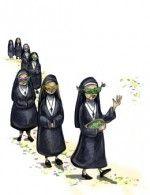Once a year, floats, masks, and gold, green and purple beads combine with thousands of people for a unique holiday: Mardi Gras.
In the U.S., Mardi Gras is often associated with heavy alcohol consumption and partial nudity, but originally stems from a religious celebration.
The origins of Mardi Gras come from the preparation of Lent, said Marcel LeJuene, assistant director of campus ministry at St. Marys Catholic Church. Its a big feast before fasting.
Lent is a Christian fast officially practiced in Catholicism that begins on Ash Wednesday, the day after Mardi Gras, and ends on Easter Sunday. Lent is a season that entails abstaining from a particular luxury for a period of time as a form of penitence. Mardi Gras, which is French for fat Tuesday, serves as a last day of indulgence before the 40-day Lenten fast.
LeJeune said the name for fat Tuesday traces back thousands of years ago. Then, it was customary to prepare and eat a fattened animal for a feast.
The fat part of the meat was considered the best the juiciest, tastiest part, LeJeune said.
According to the American Catholic website, Mardi Gras was originally celebrated in America in 1699 when a French explorer arrived at the Mississippi river 60 miles south of present-day New Orleans and named the spot Point du Mardi Gras, as it was the day of the holiday.
By the 1800s, the French in New Orleans celebrated with masquerades and parties and the official colors of the Mardi Gras celebration were chosen: purple to represent justice, green to represent faith, and gold to represent power.
The largest celebration of Mardi Gras continues to be in New Orleans, featuring parades, parties, picnics and music with traditional mask wearing and bead throwing. The main location for Mardi Gras celebration in Texas is in Galveston with similar events, along with dances and a 5,000-meter run.
The Kings Cake, another Mardi Gras tradition popular in Louisiana, is originally a part of Carnival season, a celebration period between Christmas and Mardi Gras. The Kings Cake is a ring or oval cake with sugary toppings and hidden inside the cake is a tiny plastic baby representing Jesus Christ as a child. Whoever receives the piece with the baby inside throws next years Kings Cake party.
To some, Mardi Gras has drifted away from religious significance to secular indulgence so much that some students are unaware of its historic beginnings.
I had no idea it has religious roots, said Kara Washam, senior elementary education major. It has morphed into something completely different.
Likewise, senior agronomy major Sean Miller said he didnt have much knowledge of the history of Mardi Gras and religious roots. He celebrates the holiday to have fun and as a meaningful part of his family life.
I celebrate it every year. Its been a part of my culture since I was born, and it gives us really strong family time, Miller said. Its like Christmas for us, but in February. And its a good excuse to eat and drink a lot.
For other students, the holiday retains its religious significance.
Kim Doll, senior biomedical science major, said though many see Mardi Gras simply as a farewell to freedom, it should be seen as the beginning of an important religious season.
LeJeune said while the celebration of Mardi Gras has changed and escalated in indulgence, focus can be brought back to its original purpose and meaning.
In [the] beginning, a person might have even had a beer or drink in moderation. Now its about getting drunk, LeJeune said. Celebrate responsibly, and remember that Ash Wednesday is the next day.
Doll said people are also distracted by the part of giving something up for Lent.
Lent is meant to be a time to better oneself and, through acts of kindness and focus on faith, come closer to Christ and better appreciate his sacrifice and love, Doll said.
Masquerade
February 12, 2013

0
Donate to The Battalion
$2065
$5000
Contributed
Our Goal
Your donation will support the student journalists of Texas A&M University - College Station. Your contribution will allow us to purchase equipment and cover our annual website hosting costs, in addition to paying freelance staffers for their work, travel costs for coverage and more!
More to Discover









